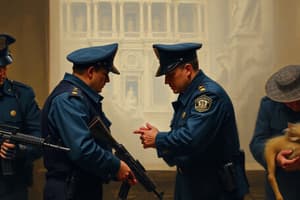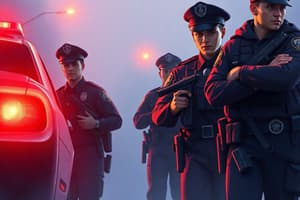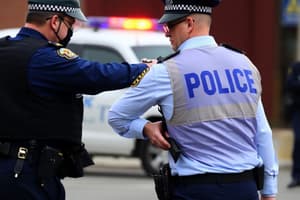Podcast
Questions and Answers
What resistance level is characterized by a subject making physically evasive movements against an officer's control attempts?
What resistance level is characterized by a subject making physically evasive movements against an officer's control attempts?
- Verbal Resistance
- Active Physical Resistance (correct)
- Passive Physical Resistance
- Aggressive Physical Resistance
Which level of resistance might cause injury but is not likely to result in death or great bodily harm?
Which level of resistance might cause injury but is not likely to result in death or great bodily harm?
- Aggravated Physical Resistance
- Passive Physical Resistance
- Aggressive Physical Resistance (correct)
- Active Physical Resistance
In which situation would an officer encounter a subject that is present but not actively resisting?
In which situation would an officer encounter a subject that is present but not actively resisting?
- Verbal Resistance
- Presence (correct)
- Aggressive Physical Resistance
- Active Physical Resistance
What type of resistance is defined by a subject not physically resisting but using verbal refusal?
What type of resistance is defined by a subject not physically resisting but using verbal refusal?
Which of the following resistance levels poses a significant threat, potentially causing death or great bodily harm?
Which of the following resistance levels poses a significant threat, potentially causing death or great bodily harm?
What is the characteristic of Passive Physical Resistance in terms of compliance?
What is the characteristic of Passive Physical Resistance in terms of compliance?
Which of the following best describes the response needed for someone exhibiting approved physical aggressive behavior?
Which of the following best describes the response needed for someone exhibiting approved physical aggressive behavior?
Which resistance level requires a response due to a subject making hostile movements?
Which resistance level requires a response due to a subject making hostile movements?
Which of the following is NOT classified as an intermediate weapon?
Which of the following is NOT classified as an intermediate weapon?
What is the primary purpose of Level 4 intermediate weapons?
What is the primary purpose of Level 4 intermediate weapons?
Which technique is prohibited when a subject is physically restrained?
Which technique is prohibited when a subject is physically restrained?
Under what circumstances can an officer utilize deadly force?
Under what circumstances can an officer utilize deadly force?
What kind of techniques fall under Level 5 incapacitating control?
What kind of techniques fall under Level 5 incapacitating control?
Which of the following statements best describes the response to increasing resistance?
Which of the following statements best describes the response to increasing resistance?
What must an officer do once compliance is reached?
What must an officer do once compliance is reached?
Which of the following is considered a counter move?
Which of the following is considered a counter move?
What is the primary purpose of an officer adopting an interview stance?
What is the primary purpose of an officer adopting an interview stance?
Which action is NOT considered a form of communication at Level 2?
Which action is NOT considered a form of communication at Level 2?
In what situation should less lethal force be utilized according to the levels of police response?
In what situation should less lethal force be utilized according to the levels of police response?
What characteristic should the officer's hands display during an interview stance?
What characteristic should the officer's hands display during an interview stance?
Which technique is used to redirect a subject to the ground effectively?
Which technique is used to redirect a subject to the ground effectively?
What is the primary goal of communication at Level 2 - Dialogue?
What is the primary goal of communication at Level 2 - Dialogue?
Why is body weight distribution important in an interview stance?
Why is body weight distribution important in an interview stance?
When should an officer consider using pain compliance techniques?
When should an officer consider using pain compliance techniques?
Flashcards
Level 1 Resistance (Presence)
Level 1 Resistance (Presence)
A subject is present and involved in suspicious activity.
Level 2 Resistance (Verbal)
Level 2 Resistance (Verbal)
The subject refuses to comply with requests or may threaten further resistance.
Level 3 Resistance (Passive Physical)
Level 3 Resistance (Passive Physical)
The subject physically resists without trying to overcome the officer.
Level 4 Resistance (Active Physical)
Level 4 Resistance (Active Physical)
Signup and view all the flashcards
Level 5 Resistance (Aggressive Physical)
Level 5 Resistance (Aggressive Physical)
Signup and view all the flashcards
Level 6 Resistance (Approved Physical Aggressive)
Level 6 Resistance (Approved Physical Aggressive)
Signup and view all the flashcards
Resistance Levels
Resistance Levels
Signup and view all the flashcards
Recommended Response
Recommended Response
Signup and view all the flashcards
Intermediate Weapon
Intermediate Weapon
Signup and view all the flashcards
Intermediate Weapons (SWAT)
Intermediate Weapons (SWAT)
Signup and view all the flashcards
Counter Moves
Counter Moves
Signup and view all the flashcards
Prohibited Strikes
Prohibited Strikes
Signup and view all the flashcards
Incapacitating Control
Incapacitating Control
Signup and view all the flashcards
Deadly Force
Deadly Force
Signup and view all the flashcards
Use of Force/Levels
Use of Force/Levels
Signup and view all the flashcards
Subject Compliance
Subject Compliance
Signup and view all the flashcards
Officer Presence
Officer Presence
Signup and view all the flashcards
Interview Stance
Interview Stance
Signup and view all the flashcards
Communication - Dialogue
Communication - Dialogue
Signup and view all the flashcards
Verbal Direction
Verbal Direction
Signup and view all the flashcards
Touch - Comfort or Attention
Touch - Comfort or Attention
Signup and view all the flashcards
Restraining Devices
Restraining Devices
Signup and view all the flashcards
Less Lethal Force
Less Lethal Force
Signup and view all the flashcards
Transporters
Transporters
Signup and view all the flashcards





